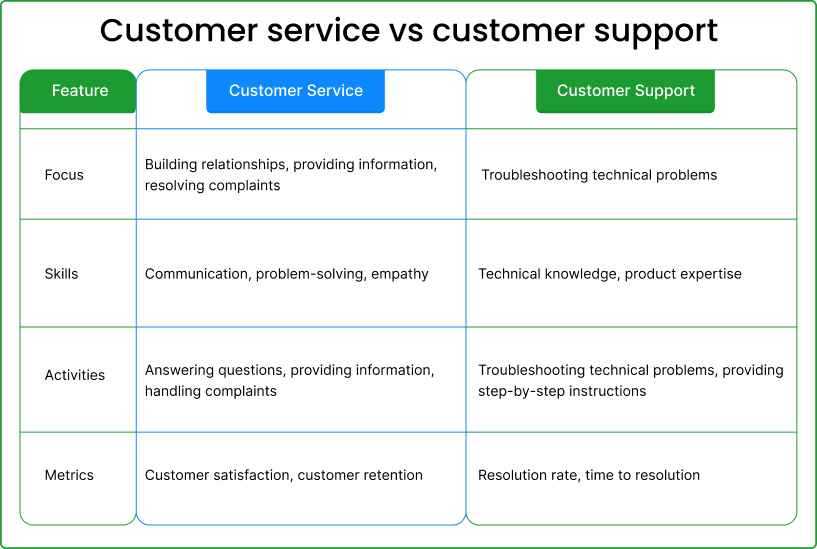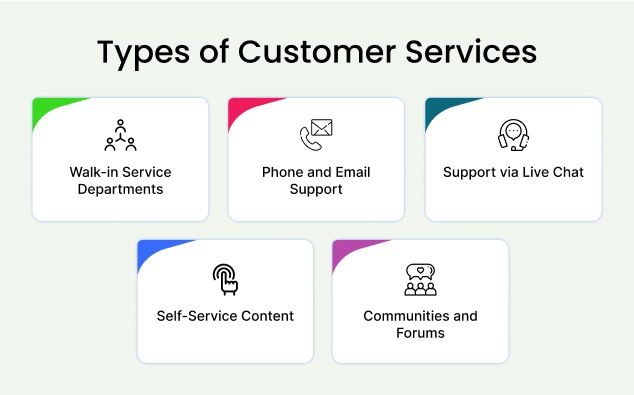 Customer Service
Customer Service

15 January, 2024

The broader spectrum of customer care has left industry leaders wondering ‘ what is customer service’. To simplify, any service that works to make customer journey and experience better is customer service. It involves addressing customer inquiries, resolving issues or complaints, and ensuring customer satisfaction.
In this article, we will explore the definition of customer service, its various types, and the important role it plays in different businesses.
Customer service is a fundamental aspect of any business that involves the direct interaction between a company and its customers. It encompasses the support provided before, during, and after a purchase. The aim is to ensure customer satisfaction and build long-term relationships.
“Customer service is the business of exceeding customer expectations through a series of positive interactions.” – Shep Hyken
For a clearer comprehension, let’s define customer service further. When a customer makes a purchase, they interact with a corporate representative on a personal level as part of customer service. This type of interaction is defined as conventional customer service. It involves making a customer feel heard, cared and valued.
Here is how the definition of conventional and non-conventional customer service differs-
In conventional times, customer service would start when the customer made a purchase or when they reached out with any issues they faced. The non-conventional modern customer service is proactive with 10X more customer service strengths.
In today’s competitive landscape of CX excellence , the definition of customer service is proactively guiding customers by anticipating their needs and providing assistance or information before they even realize they require it. This starts right when you think about starting a business.
The trend has shifted. It’s no longer about selling what you want to sell but providing what your customer actually needs to buy. Thus, this era quotes ‘ customer is the King.’ Your customer service is the King’s guard.
Customer support is a part of customer service. The distinguishing fact is that customer service refers to all types of customer-centric activities within an organization. Whereas, customer support is usually known to work as the technical support provider.

Good customer service creates strong connections with customers, resulting in higher customer retention and loyalty. Studies of companies that prioritize making customers happy show how it improves their brand reputation.
For example, [Company X] has always given outstanding customer service. As a result, they have a group of loyal customers who enthusiastically recommend them and write positive reviews online. This commitment to keeping customers satisfied has greatly improved the company’s brand image. It made them known as a reliable and dependable option in the market.
Similarly, [Company Y] has made use of customer service to stand out from their competitors. By focusing on giving personalized experiences, they have not only kept their existing customers but also attracted new ones who appreciate excellent service.
These examples demonstrate how investing in exceptional customer service can directly contribute to building customer loyalty, enhancing brand image, and ultimately driving business success.
To provide exceptional customer service, companies need to prioritize certain key components:

Micah Solomon explains customer service definition in “The Art of Selling to Anyone” saying, “Customer service is the act of transforming customers into raving fans of your brand.”
Customer service reflects the current times and varies greatly. In the past, in-person service was typical, but now there are options like store-based departments and toll-free helplines. Quality customer service is essential and the forms of support will differ by company and customer. The importance of good customer service never fades.
Walk-in service departments are physical locations where customers can receive assistance or services from a business or organization without an appointment.
Here are some other points you may find interesting about this –
Phone and Email Support are two customer service channels used by businesses to assist their customers.
It involves customers calling a business to receive assistance or resolve an issue. It provides personalized customer service and can resolve issues quickly.
Email support involves customers sending an email to a business to receive assistance or resolve an issue. It provides customer service on the customer’s own schedule.
Both phone and email support can include answering questions, providing technical support, or resolving complaints. Therefore, these are effective customer service channels for businesses to build strong customer relationships, improve customer satisfaction, and increase customer loyalty.
Tips to improve customer support through phone and email support:
Live chat support works by enabling customers to initiate a chat session with a support representative through a chat window on a website or mobile app. The chat session occurs in real-time, allowing customers to receive assistance quickly and efficiently. Businesses these days leverage both agents and customer service bots for live chat support.
Once the chat session has begun, the support representative can assist the customer by answering questions, troubleshooting issues, or providing guidance on how to use a product or service. The chat window typically includes features such as file transfers, chat history, and the ability to rate the conversation’s effectiveness.
Live chat support can provide numerous benefits to brands, including but not limited to
By following these tips, businesses can provide high-quality live chat support that meets the needs of their customers and helps to build long-lasting relationships.
Self-service content refers to resources, such as knowledge bases, FAQs, and tutorials, that are designed to help customers find answers to their questions or troubleshoot issues without requiring direct support from a representative.
Brands can be benefits from self-service content in a number of ways, such as:
Community and forum-based customer service practices involve creating an online community or forum where customers can interact with each other and receive support from both the business and other customers. This approach to customer service allows customers to ask questions, share their experiences, and get advice from others in the community.
The significance of community and forum-based customer service lies in its ability to improve customer satisfaction, increase engagement, and build brand loyalty. By creating a sense of community among customers, businesses can foster a more personal and emotional connection with their customers.
This approach to customer service can also help reduce the workload of customer support teams, as customers are able to help each other with their questions and issues.
Besides, online customer service and forums work best for businesses that have an engaged customer base, especially B2B companies where customers value peer recommendations.
Here are some tips to improve community and forum-based customer service:
Engage customers in conversations, encourage interactions, and create a sense of community among members.
Promote a positive and constructive atmosphere by enforcing community guidelines and moderating content.
Empower customers to help each other by creating a system that rewards or recognizes helpful contributions from members.
Ensure that customers receive accurate and timely responses from moderators and support teams.
Use data and analytics to track customer satisfaction, identify common issues, and improve the quality of support.
Encourage customers to provide feedback on the quality of support, the community atmosphere, and the overall customer experience.
Offer incentives or rewards to encourage customer participation and engagement, and to acknowledge customers for their contributions.
Regularly evaluate the effectiveness of the community and forum-based customer service, and make adjustments as necessary to improve the quality of support and customer experience.
End Note
The success of a business depends on its ability to provide world-class customer service. Many factors in 2024 will affect a company’s success, including how a company defines customer services and their values.
By the end of this blog, if you’ve gained a clear perspective on what customer service is, it’s time to take action and strategize for the excellent service your customers deserve.
Check also: How is Customer Service Measured for Success in Business